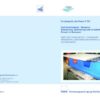Description
P 757 – Steel Light Composite (SLC) Construction Development, optimisation and economic use in civil engineering
Steel composite structures could be used efficiently in the construction sector. Innovative solutions will increase the market share in bridge construction and multi-storey buildings. Due to this fact further development and optimization of steel composite structures are helpful.
In the course of this research project steel light composite construction modules consisting of (ultra-) high performance materials (HSS and UHPC) for floor systems have been developed. With these modules it is possible to bridge wide spans with a minimized overall slab height. A high load-bearing capacity of the shear connector is a necessity for the use of (ultra-) high performance materials. Headed studs are only suitable for this task with limitations, so instead of them continuous shear connectors with a puzzle shaped steel dowel were used as an innovative connection. The usage of honeycomb – steel beams has been proven to be particularly efficient. Already when cutting the honeycomb beam the puzzle shaped dowel can be cut in the web plate, further steps for the realization of the shear connection are unnecessary. In addition, the web plate openings can be used very efficiently for installation of the technical building equipment, this allows to save construction height.
The load bearing and deformation behaviour of the shear connector was analysed in extensive experimental research and the applicability of the existing design models in the literature are reviewed. It could be shown that a design model, which was developed for continuous shear connectors in composite bridges, the load bearing behaviour sufficiently. The dynamic characteristics and the load bearing behaviour and deflections of light steel composite modules were investigated in numerical calculations and a de-eingesign concept for the verification has been developed. The results of the FE – analyses were additionally verified in full scale tests. The investigations have shown that the use of hot rolled sections with S355 and S460 lead to economical designs.
In economic feasibility studies based on the manufacturing and assembly costs, the steel light composite modules were compared to conventional in-situ concrete solutions for a reference building. The high cost of materials for ultra-high-strength concrete is the essential price-setter for the steel light composite elements. Potential savings were identified and presented as well as conceptual proposals for a further improvement of efficiency and profitability.
The research project has been carried out at Lehrstuhl Stahlbau of Technischen Universität Dortmund. FOSTA has accompanied the research work and has organized the project funding from the Foundation for Steel Application Research.
Only available in german language.
Authors:
G. Seidl, M. Stambuk, D. Ungermann, S. Schneider
Published in:
2014




